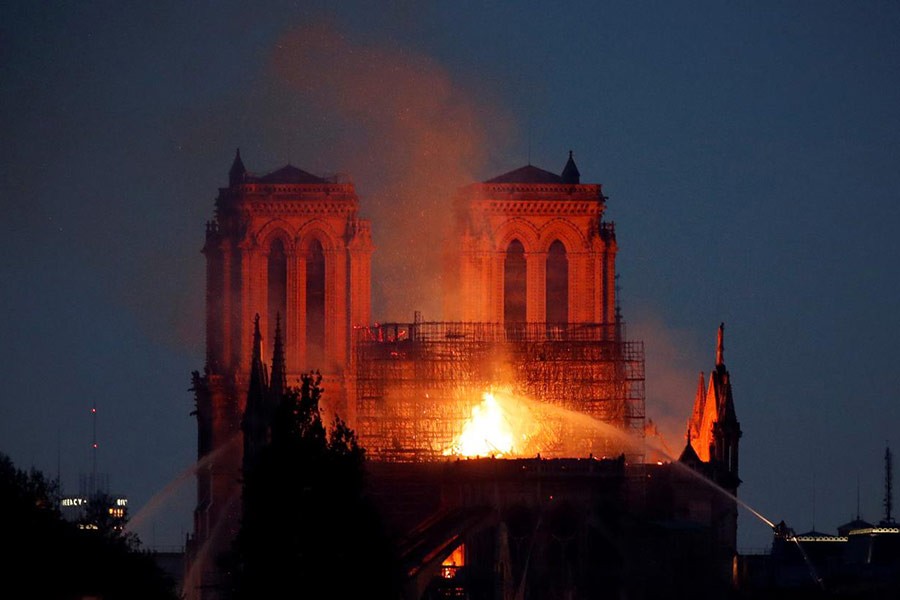The catastrophic fire in Notre Dame (on April 15-16, 2019) produced a massive emotional reaction. In a Paris famous for its secularism tearful people knelt on the pavement, sang the Ave Maria and prayed to God to save their cathedral. Several stated that it was not only a church burning, but the soul of Paris passing away. What did they mean to say?
In Rome I was once told that even if all people were removed from it, that town would still be alive. An observation similar to the one of ancient Romans, who assumed that specific places were kept alive by the presence of divine forces called genii locorum.
Around 64 CE, in one of 124 letters to his friend Lucilius, the philosopher and author Seneca wrote:
If ever you have come upon a dense wood of ancient trees that have risen to an exceptional height, shutting out all sight of the sky with one thick screen of branches upon another, the loftiness of the forest, the exclusion of the spot, your sense of wonderment at finding so deep and unbroken a gloom out of doors, will persuade you of the presence of a deity.
Feelings of a spiritual presence are common to most cultures. For example, Japanese kami are elements of the landscape; forces of nature, as well as various living and deceased beings, like the spirits of venerated dead persons. In Shintoism impressive natural manifestations, even those that to others may appear as being insignificant, may carry divine messages, like in a haiku by Hoshinaga Fumio (b. 1933):
Flicking off water a dragonfly quickly becomes divine.
A place imbued with a sense of enigmatic presence may be considered as a sacred venue. Terms like sacred and holy tend to be used interchangeably, though holiness is actually related to persons, while sacredness refers to objects, places, or happenings. However, both words denote something different from everyday existence and thus worthy of being respected. The Latin word sanctum means "to set apart". A sacred place may be referred to as a hierophany [Greek hieros - holy and phanein - to reveal/bring to light], or as the historian of religions Mircia Eliade describes the term "breakthroughs of the sacred into the World."
A sacred place represents interests and profound feelings of an individual and/or a group of people. A site of reference, a centre which through its tangible existence provides stability and meaning to our lives. To enter a church, a mosque or any other holy temple or secluded space venerated by deeply religious people may even for a non-believer create feelings of tranquillity and reveration.
In the very centre of Paris stands Our Lady of Paris, Notre-Dame de Paris, a magnificent gothic cathedral. Notre-Dame has throughout centuries been at the heart of a city fostering creativity, strong feelings and it has often even been called The Capital of Love.
In 1831, Victor Hugo published his novel Notre-Dame de Paris while declaring that his intention had been to make his contemporaries aware of how medieval piety had been expressed through the splendour of Gothic architecture. At the time, magnificent French cathedrals were being neglected and often destroyed to be replaced by new buildings or defaced in the name of "modernity". What particularly pained Victor Hugo was that during the revolution of 1830 a fire had broken out and severely damaged the three rosette windows of his beloved Notre Dame. Parisian authorities had voted to replace these chefs d´oeuvre of Christendom with plain glass windows to "bring more light into the gloomy cathedral." It is probable that Hugo´s magnificent novel about Quasimodo, the kind-hearted, crippled and ugly custodian of the Cathedral and his impossible love for the beautiful Esmeralda, saved Notre Dame from this thoughtless profanation. The Cathedral is actually the most significant aspect of Hugo´s novel. The focal point of a prodigious epic depicting an entire epoch. A comprehensive panorama of an entire people, represented by characters caught in the whirlwind of history. It was one of the first novels that tried to encompass the entirety of a city, from the royal courts down to the depths of its sewers.
Notre Dame is the genius loci of Paris, its sacred, living heart. Seeing it engulfed by flames was a painful experience for everyone who has learned to love the city and the splendour of human endeavours. A monument like Notre Dame is not only a magnificent building. It encapsulates human piety, our striving for peace and unity.
To watch the burning Notre Dame reminded us of how entire, wondrous cities like Dresden and Aleppo were bombed and burned to cinders. How World Heritage like the giant Buddhas of Bamiyan, or temples in Palmyra, were intentionally destroyed by fanatics. It is not only monuments that are being destroyed. Such acts of pityless vandalism constitute attacks on our common sense of piety, our feelings of unity and humility while we face the perils of human existence. When the Spirit of Place, like Notre Dame, burns and is destroyed, the human soul also suffers.
Jan Lundius holds a PhD. on History of Religion from Lund University and has served as a development expert, researcher and advisor at SIDA, UNESCO, FAO and other international organisations.
— Inter Press Service


